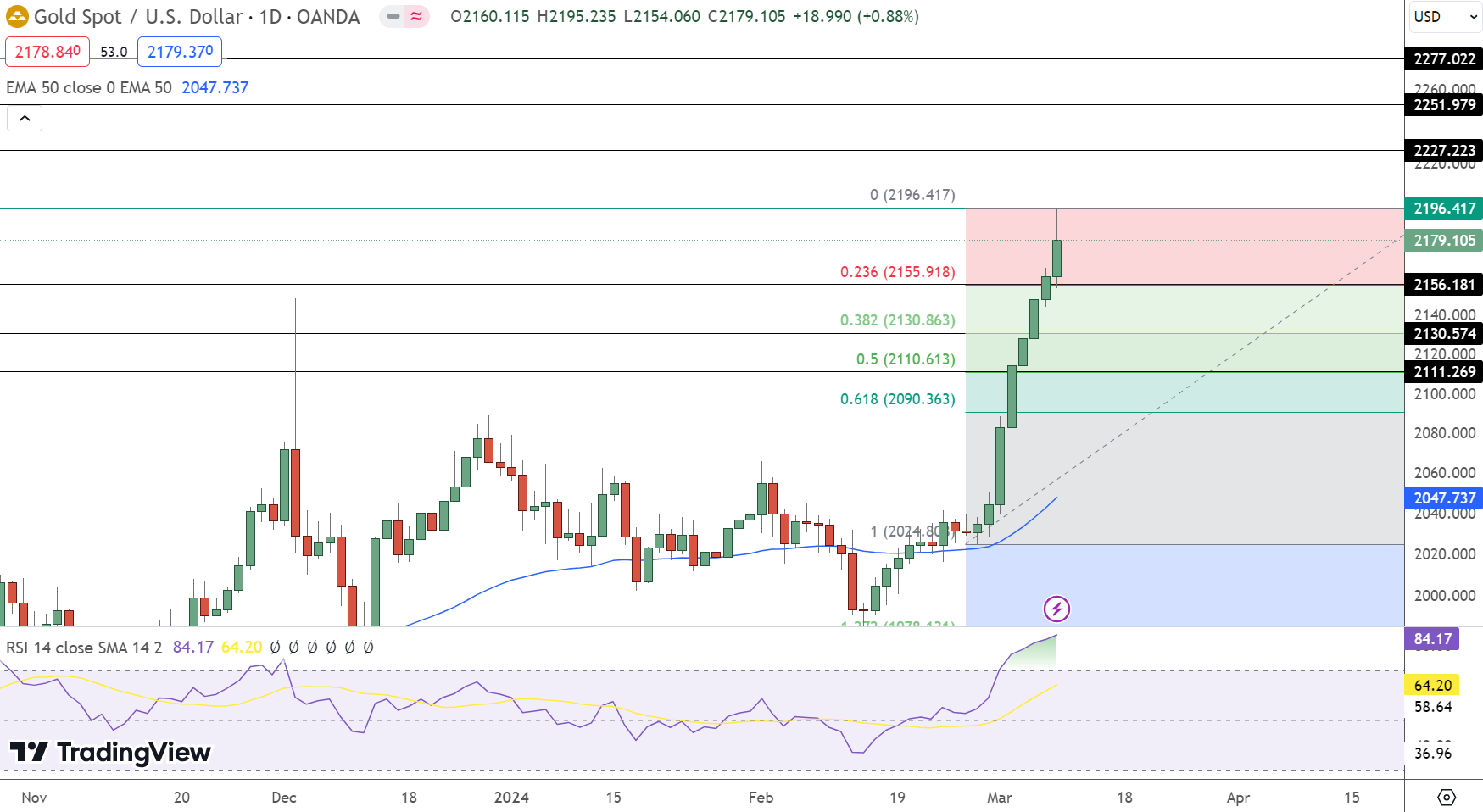Gold
Gold (XAU/USD) concluded the week on a high note, appreciating by 4.63% to close at $2179.105. Most of it was propelled by a dip in 10-year US bond yields to 4.04% post-US NFP data release. This slowdown in wage growth and a spike in the Unemployment Rate has stirred expectations for the Federal Reserve (Fed) to consider interest rate cuts at the June policy meeting.

Labor Data’s Impact on Gold Price Dynamics
The Bureau of Labor Statistics (BLS) reported a rise in the Unemployment Rate to 3.9%, overshooting forecasts with a previous figure at 3.7%. Furthermore, February’s Nonfarm Payrolls (NFP) exceeded expectations at 275K versus an anticipated 200K, albeit lower than the prior 353K, indicating a mixed labor market.
These labor market dynamics suggest a cautious approach to gold trading in response to economic indicators and policy decisions.
Gold Responds to Inflation and Wage Growth Signals
The interplay between inflation trends and wage growth remains a crucial factor influencing gold prices in the current market environment.
The outlook for inflation is becoming subdued as Average Hourly Earnings increased by merely 0.1% month-over-month against January’s 0.6% hike. This slowdown in wage growth, with annual rates cooling to 4.3% from an expected and previously adjusted 4.4%, suggests softer inflationary pressures.
Fed Chair’s Commentary Strengthens Gold’s Position
The US Dollar weakened, evidenced by the US Dollar Index (DXY) hitting a seven-week trough at approximately 102.40, amid reduced wage inflation. Additionally, Fed Chair Jerome Powell’s remarks on nearing the Fed’s 2% inflation target reassured markets. His optimism about easing monetary restrictions without triggering a recession buoyed gold investors.
Critical US Economic Events to Watch
The upcoming week is crucial for gold traders, with several key US economic indicators on the horizon:
Traders should closely monitor these economic events to gauge potential impacts on gold prices and investment decisions.
- Core CPI is anticipated at 0.3%, with CPI month-over-month expected at 0.4% and year-over-year at 3.1%, closely watched on March 12.
- Bond auctions on March 12 and 13, with a 10-year yield at 4.09|2.6 and a 30-year yield at 4.36|2.4, may impact interest rate perceptions.
- Key data on March 14, including Core PPI month-over-month at 0.2% and Retail Sales month-over-month projected at 0.8%, alongside Unemployment Claims estimated at 218K, will provide insights into economic momentum and inflation.
- The week caps off on March 15 with the Empire State Manufacturing Index at -7.6 and Preliminary University of Michigan Consumer Sentiment at 77.3%, along with Inflation Expectations at 3.0%, offering a glimpse into consumer outlook and inflationary trends.
These figures and events will critically influence the Gold (XAU/USD) price forecast, guiding investor sentiment and market dynamics in the near term.
Gold (XAU/USD) Price Forecast: Technical Outlook
Gold (XAU/USD)’s pivot point stands at $2196.42, serving as a linchpin for future price action. Resistance levels are staged at $2227.22, $2251.98, and $2277.02, marking potential targets for upward movements.
Conversely, support levels are identified at $2156.18, $2130.57, and $2111.27, providing cushions for any downward price corrections.

Technical analysis reveals an RSI of 84, suggesting an overbought condition that could precede a pullback. However, the 50-Day Exponential Moving Average (EMA) at $2047.74 and the formation of a ‘Three White Soldiers’ candlestick pattern underscore a strong bullish momentum. A decisive breach above the $2196.42 level could further energize the bulls, potentially propelling gold towards the $2227.22 mark and beyond.
In summary, the outlook for gold is cautiously optimistic. While bearish below $2196.42, a break above this threshold may invigorate a more pronounced bullish bias, underscoring the dynamic nature of the gold market.
**Additional Insight:**
The recent surge in the price of gold, driven by NFP data and market dynamics, reflects a complex interplay between labor market statistics and inflation indicators. Investors should closely monitor economic events and policy decisions to navigate the uncertainties in the gold market. Technical analysis suggests a cautious yet optimistic approach, with key support and resistance levels shaping future price movements.
By examining the broader economic landscape and Fed commentary, traders can gain valuable insights into the factors influencing gold prices. As the market evolves, adapting strategies to respond to changing conditions will be essential for maximizing investment potential in the gold sector.








